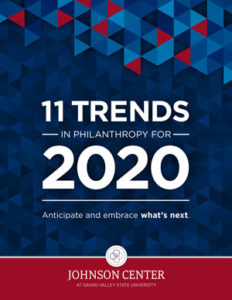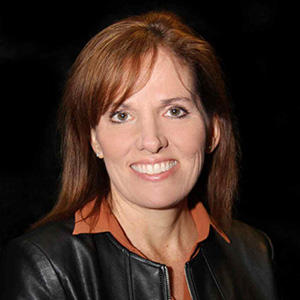Corporate Social Responsibility Employs Many Models to Strategically Align Business and Philanthropy


 This article was first published in our 11 Trends in Philanthropy for 2020 report. Explore the full report here.
This article was first published in our 11 Trends in Philanthropy for 2020 report. Explore the full report here.
Want the latest trends, research, and more delivered right to your inbox? Subscribe to the Johnson Center email newsletter.
In 11 Trends in Philanthropy for 2019, Michael Moody (2019) noted that for-profit organizations are now embracing social impact as part of their mission. While there are a variety of terms in use (corporate citizenship, triple bottom line, etc.), corporate social responsibility (CSR) is often used as an overarching term. CSR can be defined as actions outside an organization’s normal scope of business that seek to address the needs of the community beyond pure economics (Carroll, 1999). These activities seek to align social good and ethical obligations with business objectives. CSR is a function to meet — and hopefully exceed — stakeholder expectations.
It is important to note that CSR and corporate philanthropy are not synonymous. CSR is broader in scope and encompasses many ways that corporations contribute to social good, one of which is corporate philanthropy. Where corporate philanthropy seeks to address social change through the allocation of time, financial, and other resources, CSR takes the practice one step further to strategically align philanthropic efforts with business objectives (Lazarri, 2018).
“Where corporate philanthropy seeks to address social change through the allocation of time, financial, and other resources, CSR takes the practice one step further to strategically align philanthropic efforts with business objectives.”
Craig Smith (2013) suggests this concept has a long history, as organizations have documented instances where they have engaged in community issues and needs since at least the 19th century. Others suggest it was the Great Depression when organizations began helping society as part of their role. Formally, scholars and business analysts have been studying and attempting to define the concept of CSR since the 1940s (Bowen, 1953).
Regardless of the origins, the 2010s were bookended by two major events related to CSR. In 2010, the International Standards Organization, the international body that sets standards in a broad range of topics related to business and trade, issued ISO 26000 to provide guidance on operating a business in a socially responsible way. As the decade came to a close, the Business Roundtable (2019), which includes the CEOs of 200 major corporations, declared that the purpose of a corporation is to deliver value to all stakeholders, including communities, employees, and suppliers, and to protect the environment. This is a major departure from the previous stance that increasing shareholder value is the sole purpose of an organization.
Throughout this last decade, CSR in various shapes has taken deeper root. A 2015 KPMG Survey of Corporate Responsibility Reporting estimated that 92% of the Fortune 250 took action toward a larger social mission and produced an annual report summarizing their actions and impacts. These activities vary widely, but share the intent to benefit both the “organization” — through motivated employees and increased profits — and the “community” it serves — by addressing relevant social issues. Further, 82% of the S&P 500 produced reports detailing their CSR initiatives in 2016, a significant increase from less than 20% reporting their CSR efforts in 2011 (Coppola, 2017).
Definitions and models attempting to explain the CSR phenomena have evolved significantly over the years. Early analysis focused on the obligation of businesses to consider how their decisions impact surrounding communities and meet public expectations (Davis & Blomstrom, 1966). Archie Carroll’s (1999) CSR Pyramid sought to reconcile four categories of business responsibilities — economic, legal, ethical, and philanthropic — stating that organizations’ philanthropic responsibility didn’t begin until profitability occurred. Newer models attempt to situate CSR and market value within a single conceptual framework (García-de-Madariaga & Rodríguez-de-Rivera-Cermades, 2010).
Another recent approach by Tracee Keys, Thomas Malnight, and Kees van der Graaf (2009) is to use McKinsey & Co.’s matrix, which pinpoints CSR’s primary objective: to align successful business practices while pursuing benefits to society. Ultimately, this model leads to “strategic” CSR that results in high benefits for society and for business, recognizing that organizational practice’s range and subsequent benefits to society and the organization also vary accordingly.
The matrix demonstrates that some efforts have a higher benefit to society than to business. At the low-impact, “pet projects” level, employees may ask those in the workplace to adopt a family during the holidays. More significant giving occurs in “philanthropy,” where the organization may identify a charitable cause to support throughout the year. These examples could be classified as corporate philanthropy.
“Although more and more companies are engaging in and reporting on their CSR activities, commitment levels are wide ranging, and thus the benefits are too.”
What Keys and colleagues label as “propaganda” are efforts in which the benefits to society are low, but high to the organization. For example, a hotel asking guests to help save the environment by not having linens washed daily during their multi-day stay may or may not benefit society. However, the financial savings to the organization is significant.
Finally, those actions of high value to both the organization and society are defined as “strategic.” These include practices that center around the organization, from employee volunteerism in human resources to fair trade supplier relationships; or practices that are externally focused, from energy and waste saving practices to disaster relief.
Although more and more companies are engaging in and reporting on their CSR activities, commitment levels are wide-ranging, and thus the benefits are too. What also varies is the size and types of organizations taking strategic action.
While top performers in the private sector are the most documented, the CSR trend isn’t limited to only the largest of organizations. Small and medium enterprises (SMEs) are embracing CSR, however, some scholars suggest fewer are producing annual reports and engaging with CSR as a strategic initiative (Perälä & Saukkonen, 2017). Yet, small businesses account for nearly half of the U.S. workforce and over 30 million organizations (Giese, 2019). Further, of the 5.6 million employer firms in the U.S. in 2016, “the vast majority (88%) of employer firms have fewer than 20 employees, and nearly 40% of all enterprises have under $100k in revenue” (JP Morgan Chase & Co., n.d.). In fact, 98.2% of firms have fewer than 100 employees (SBE Council, 2018).
Despite their undeniably large part in the U.S. workforce, the Global Reporting Initiative found that only 10% of SMEs conduct annual sustainability reports (GRI, 2016). As such, SMEs are not reaping the same CSR benefits as those that have strategically implemented and publicly report their philanthropic initiatives.
CSR will continue to evolve strategically for SMEs as they too will benefit their communities and help solve social issues while, in turn, more successfully achieving their organizational objectives.


Bowen, H. R. (1953). Social responsibilities of the businessman. New York, NY: Harper & Row.
Business Roundtable. (2019, August 19). Statement on the purpose of a corporation. Retrieved from https://opportunity.businessroundtable.org/wp-content/uploads/2019/12/BRTStatement-on-the-purpose-of-a-Corporation-with-Signatures.pdf
Carroll, A. B. (1999). Corporate social responsibility: Evolution of a definitional construct. Business & Society, 38(3), 268–295. Retrieved from https://doi.org/10.1177/000765039903800303
Chase, L., Karim, S., & Rangan, K. (2015). The truth about CSR. Harvard Business Review. Retrieved from https://hbr.org/2015/01/the-truth-about-csr
Coppola, L. (2017, May 31). Flash report: 82% of the S&P 500 companies published corporate sustainability reports in 2016. Retrieved from https://www.3blmedia.com/News/Flash-Report82-SP-500-Companies-Published-Corporate-SustainabilityReports-2016
Davis, K. & Blomstrom, R. L. (1966). Business and its environment (7th ed.). New York, NY: McGraw Hill.
Font, X. & Lynes, J. (2018). Corporate social responsibility in tourism and hospitality. Journal of Sustainable Tourism, 26(7), 1027–1042. Retrieved from https://doi.org/10.1080/09669582.2018.1488856
García-de-Madariaga, J. & Rodríguez-de-Rivera-Cremades, F. (2010, May/August). Corporate social responsibility and the classical theory of the firm: Are both theories irreconcilable? Innovar, 20(37), 5–19. Retrieved from http://www.scielo.org.co/scielo.php?script=sci_arttext&pid=S0121-50512010000200002
Giese, C. (2019, October 7). How many small businesses are in the U.S.? (And other employment stats) [Blog post]. Retrieved from https://www.fundera.com/blog/small-business-employmentand-growth-statistics
Global Reporting Initiative (GRI). (2016, October 5). Making the case for SME sustainability reporting. Retrieved from https://www.globalreporting.org/information/news-and-press-center/Pages/Small-Business,-Big-Impact-Making-the-case-for-SMESustainability-Reporting.aspx
JP Morgan Chase & Co. (n.d.) Small businesses are an anchor of the US economy. Retrieved from https://www.jpmorganchase.com/institute/research/small-business/small-business-dashboard/economic-activity
Kania, J., Kramer, M., & Russell, P. (2014, Summer). Strategic philanthropy for a complex world. Stanford Social Innovation Review. 26–37. Retrieved from https://ssir.org/up_for_debate/article/strategic_philanthropy
Keys, T., Malnight, T. W., & van der Graaf, K. (2009, December). Making the most of corporate social responsibility. Retrieved from https://www.mckinsey.com/featured-insights/leadership/making-the-most-of-corporate-social-responsibility
KPMG. (2015, November 25). The KPMG survey of corporate responsibility reporting 2015. Retrieved from https://home.kpmg/xx/en/home/insights/2015/11/kpmg-international-survey-ofcorporate-responsibility-reporting-2015.html
Lazzari, Z. (2018, October 22). The difference between corporate philanthropy and corporate social responsibility. Chron.com. Retrieved from https://smallbusiness.chron.com/difference-between-corporate-philanthropy-corporate-socialresponsibility-65129.html
Moody, M. (2019, February 13). The boundaries are blurring between philanthropy and business. 11 Trends in Philanthropy for 2019 (pp. 5–6). Retrieved from https://johnsoncenter.org/blog/the-boundaries-are-blurring-between-philanthropy-and-business/
Perälä, V. & Saukkonen, A. (2017). Exploring the usage of CSR in small and medium-sized companies (Bachelor’s thesis). Retrieved from https://pdfs.semanticscholar.org/6fd3/0b138a5d440efc707c37f7e3e9656dfa16b0.pdf
Small Business & Entrepreneurship Council. (2018). Facts & data on small business and entrepreneurship. Retrieved from https://sbecouncil.org/about-us/facts-and-data
Smith, N. C. (2013, August 14). When it comes to CSR, size matters. Forbes. Retrieved from https://www.forbes.com/sites/insead/2013/08/14/when-it-comes-to-csr-size-matters